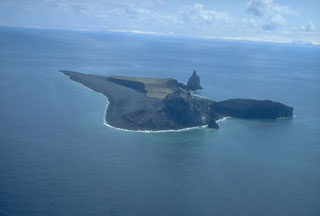Report on Bogoslof (United States) — 21 December-27 December 2016
Smithsonian Institution / US Geological Survey
Weekly Volcanic Activity Report, 21 December-27 December 2016
Managing Editor: Sally Sennert.
Please cite this report as:
Global Volcanism Program, 2016. Report on Bogoslof (United States) (Sennert, S, ed.). Weekly Volcanic Activity Report, 21 December-27 December 2016. Smithsonian Institution and US Geological Survey.
Bogoslof
United States
53.93°N, 168.03°W; summit elev. 150 m
All times are local (unless otherwise noted)
AVO reported that the explosive eruption at Bogoslof, which was reported by several pilots around 1530 on 20 December and produced an ash plume that rose to 10.3 km (34,000 ft) a.s.l., lasted about 30 minutes. The ash plume detached and dispersed S. AVO had raised the Aviation Color Code (ACC) to Red and the Volcano Alert Level (VAL) to Warning, but since no further activity was detected or observed the ACC was lowered to Orange and the VAL was lowered to Watch. On 21 December periods of discrete earthquakes and continuous seismic tremor were recorded by instruments on nearby volcanoes. At 1610 an explosive eruption detected in satellite data and by seismic instruments on nearby islands again lasted about 30 minutes. An ash plume rose to an altitude of 10.7 km (35,000 ft) a.s.l. and drifted N. The ACC and VAL were raised to Red and Warning, respectively. Seismicity declined rapidly afterward and remained low; the ACC was lowered to Orange and the VAL was lowered to Watch. Strong continuous seismic activity started abruptly at about 1340 on 22 December.
AVO noted that the eruption had dramatically changed the island. Satellite images showed that a small new island had formed just offshore of the NE end of the main island, the previous shore and much of the NE side of Bogoslof Island adjacent to the new island had been mostly removed (and was likely the site of the new, underwater vent), and deposition of material had occurred on the W side of the island.
An explosion occurred at 0930 on 23 December. A Coast Guard ship in the vicinity reported ash emissions, lightning, and ejected lava and fragmented material. The ash plume rose to an altitude below 9.1 km (30,000 ft) a.s.l. Coast Guard observers noted that ash emission subsided around 1037. The ACC/VAL were raised to Red/Warning. On 24 December seismic unrest was periodically detected by nearby island networks, but levels were generally low. The ACC was lowered to Orange and the VAL was lowered to Watch. A period of tremor detected in the evening on 25 December may have been associated with a minor, low-level ash emission (below 3 km or 10,000 ft a.s.l.); several lightning strikes in the area were recorded. Lightning strikes, seismic data, and satellite images indicated a continuing eruption that began at 1405 on 26 December. An ash plume rose to an altitude of 9.1 km (30,000 ft) a.s.l. and drifted WSW. The ACC/VAL were again raised to Red/Warning.
Geological Summary. Bogoslof is the emergent summit of a submarine volcano that lies 40 km N of the main Aleutian arc. It rises 1,500 m above the Bering Sea floor. Repeated construction and destruction of lava domes at different locations during historical time has greatly modified the appearance of this "Jack-in-the-Box" volcano and has introduced a confusing nomenclature applied during frequent visits by exploring expeditions. The present triangular-shaped, 0.75 x 2 km island consists of remnants of lava domes emplaced from 1796 to 1992. Castle Rock (Old Bogoslof) is a steep-sided pinnacle that is a remnant of a spine from the 1796 eruption. The small Fire Island (New Bogoslof), about 600 m NW of Bogoslof Island, is a remnant of a lava dome formed in 1883.
Source: US Geological Survey Alaska Volcano Observatory (AVO)

